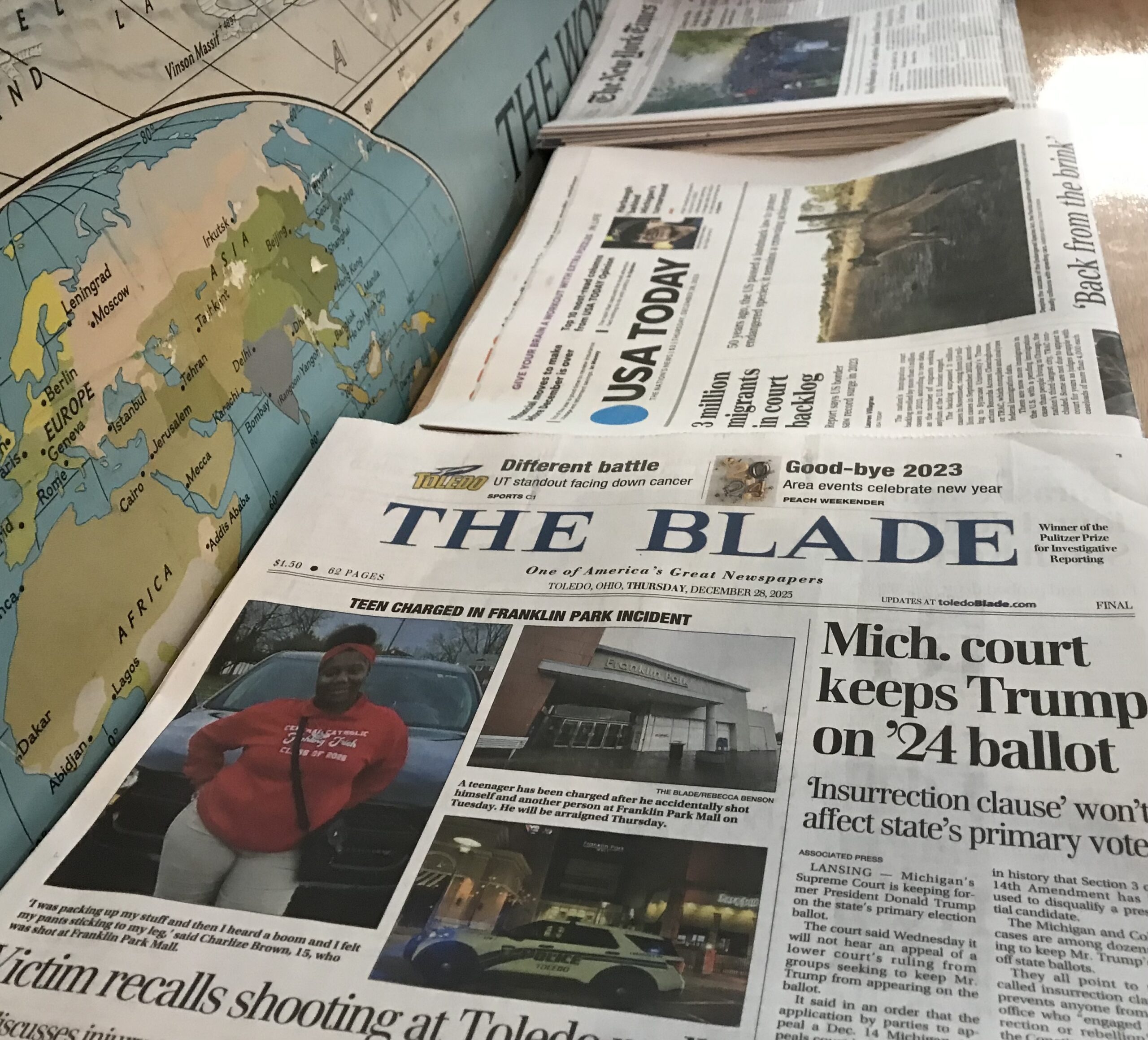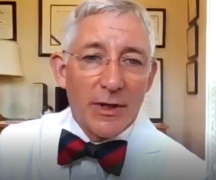I always love when I come across some overlooked resource that’s long been around, waiting to be noticed. And I had just such an experience when I moved to the Milo-Grogan neighborhood several weeks ago and wandered into the State Library of Ohio.
Housed in the cavernous former Jeffrey Mining factory at 274 E. 1st Ave., it traces its history back to the early 19th century and it serves as a repository for federal documents. Lots of them. You can find soil reports from around the world on its many shelves, for example.
But it has a wealth of other things besides.
What caught my eye on a quick tour was that it had two large bookcases full of volumes about journalism. Who knew that there was so much to write about writing the news?
But people do like to talk about themselves, and when those people are sort-of writers I suppose a large number of books about how they and their colleagues spend their days is inevitable.
One of the many at the state library was Stanley Walker’s “City Editor,” an account of the American newspaper industry published in 1934. Walker, a Lampasas, Texas, native, wrote it as he was leaving his gig as city editor of the New York Herald Tribune.
It turned out to be a book I had a hard time putting down.
To the unfamiliar, the city editor is in charge of reporters covering “hard” local news. Think city council, cops, schools, local scandals and controversies. In a lot of ways, the city desk is the beating heart of the newsroom.
I’ve always been a big geek about history, and in recent years, I’ve become increasingly obsessed with what it was like back when.
For example, I spend endless amounts of time trying to imagine how different things must have been when people couldn’t go home and flip on the TV, the radio, or even the lights. I’m sure that lacking those things, they read more and went to bed earlier. But there must also have been profound differences in the pace of their lives and how they saw the world.
So, when I saw a newsman’s account of the newsroom of 90 years ago, I knew I had to read it. When I worked in The Columbus Dispatch’s 62 E. Broad Street office, I often speculated about what it was like when those rooms housed the Ohio State Journal in the 1920s. I guessed it was smokey and loud and foreign in a lot of ways; different people using different technology, different language — and who had different ideas about what makes news.
Yes and no, I learned from Walker’s book.
A deft writer, he summed up what I and most of my colleagues think of the newsroom as he described what a beginning (male) reporter would find there.
“Such a young man will find for all the dreary interludes, that he has been plumped down in the midst of the liveliest and most amusing of worlds,” Walker writes. “It is for him like attending some fabulous university where the humanities are studied to the accompaniment of ribald laughter, the incessant splutter of an orchestra of typewriters, the occasional clinking of glasses, and the gyrations of some of the strangest performers ever set loose by a capricious and allegedly all-wise creator.”
When it comes to strange performers, I have a list, and it keeps growing.
Walker also demonstrates the drollery that I like to think is better in the newsroom than anywhere else.
He described Charles Chapin, city editor of the New York Evening World, who “was generally hated” after firing more than 100 reporters over the course of his career. Those remaining were understandably anxious to please him.
On one occasion a reporter wrote about the “melancholy waters” of the East River in which a body was found floating. Chapin said he liked the phrase.
“He was overheard; thereafter for days, the Harlem River, the Gowanus Canal and Spuyten Duyvil all developed ‘melancholy waters,’” Walker wrote.
Chapin then promised to fire the next reporter to use the expression. But one, Dwight Perrin, didn’t get the word and started a story, “The melancholy waters of the Hudson.”
As he fired Perrin, Chapin demanded:
“‘How could the waters of the Hudson be melancholy?’
‘Perhaps,’ suggested Perrin, ‘It was because they had just gone past Yonkers.’
‘Not bad,’ said Chapin. ‘You’re hired,’” Walker wrote.
In the book are also the timeless barbs editors and reporters have for each other as they struggle to put out the news.
Reporters then complained of an editor’s “itching pencil” changing their stories not to improve them, but instead to put the editor’s stamp on them. Pencils are no longer involved, but reporters often have similar complaints now. Such editors have always borne a strong similarity to dogs that feel the need to pee on every tree in sight.
Walker held similar antipathy for preening reporters who thought their overwritten prose perfect in its original form. “Word painters,” he jibed.
He gives newspaper writing advice that will always be good — “Sentences and paragraphs should be short,” and “Because one adjective is as revealing as a lightning flash, don’t think that 10 will make the story 10 times as good.”
And there are the mocking methods editors have always used to get their reporters to use the language more precisely.
“A building is usually ‘situated,’ not ‘located,’ unless the Missing Person’s Bureau has been searching for it and has found it,” Walker wrote.
Common usage has changed over nine decades and I doubt there’s any problem now with saying a house is located at 123 Main St. But the principle behind all those seemingly arbitrary rules hasn’t changed: The more consistent the usage, spelling, grammar, and punctuation, the more easily the prose is understood.
There are ways in which Walker was clearly stuck in an earlier, worse time. When he refers to “race,” he means Italian, Irish, Jewish or some other then-looked-down-upon subset of what we now know as “white.” And he points out that people are “negro” when there was no reason to do so — except that anti-Black racism was then so ingrained that one’s blackness was a trait never to be forgotten.
Also, when he refers to journalists generally, Walker incessantly uses some variation of “newsman.”
That’s despite the fact that he devotes an entire chapter to the many women journalists who were then working and the fact that some had been doing so for 50 years. Ironically, Walker argues against pigeonholing female reporters.
“There has been much meaningless talk, among the soothsayers of journalism, about hiring women to present ‘the woman’s viewpoint,’” Walker wrote. “To suppose that, because God in his whimsy created her thus and so, a woman is peculiarly fitted to write of women’s sports, women’s clothes, women’s clubs, women’s flower shows, women’s political ambitions, and to interview women, is as ridiculous as to assume that a clergyman is the ideal man to cover religious news.”
He adds, sadly, that more women didn’t cover hard news “not (because) they couldn’t do it just as well, but they shrink from the razzing of their colleagues.” They faced relentless gender-based harassment, in other words.
There are other, less-dispiriting ways in which Walker speaks to us from another time. He writes excitedly of the expanding role photos were playing in newspapers as the technology improved.
To the photojournalists themselves, he pays a backhanded compliment, describing them as, “That motley aggregation of impudent and flattering camp followers, the photographers for the newspapers and the picture services, must be ranked with the top flight of newspaper men.”
Walker also writes of an older reporter who relayed sports coverage to a telegraph operator in the late 1880s. It seems hopelessly distant now, but for him these were war stories from a more-seasoned colleague. A living memory.
With the accelerating pace of communication technology, such stories continue. I can remember the newsroom before the internet — which we then capitalized as the ‘Internet’ — archaic as that seems today.
The threat posed by technology was true in Walker’s time just as it is in ours.
At the time he was writing, the country was in the fifth year of the Great Depression and New York had gone through a brutal round of newspaper consolidation, thanks in good part to the work of Frank Munsey. Reporters who weren’t laid off took deep pay cuts — something their descendants got a taste of in the Great Recession.
And it might seem quaint now, but the journalists of Walker’s day worried over how their newspapers might be harmed by the cutting-edge technology of radio.
Almost nobody owned one in 1923, but by 1930, 40% of households had radios and by 1940, 90% would. Newspapers wondered how they could possibly compete.
“The fight between the newspapers and the radio broadcasting companies has been going on ever since it was discovered that news events could be transmitted to the public through the air with a speed which makes the printing press look like some hopelessly archaic piece of junk,” was how Walker opened his chapter on radio.
He couldn’t know that newspapers would find a way then and through the advent of television. Just as we can’t know what will happen to news on an internet that seems far more hospitable to gaslighting and garbage.





